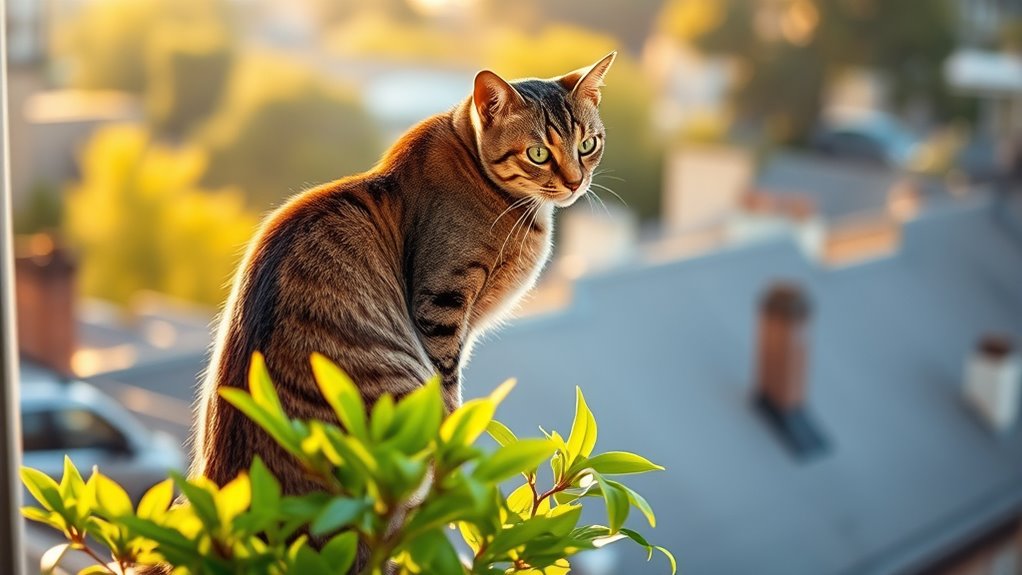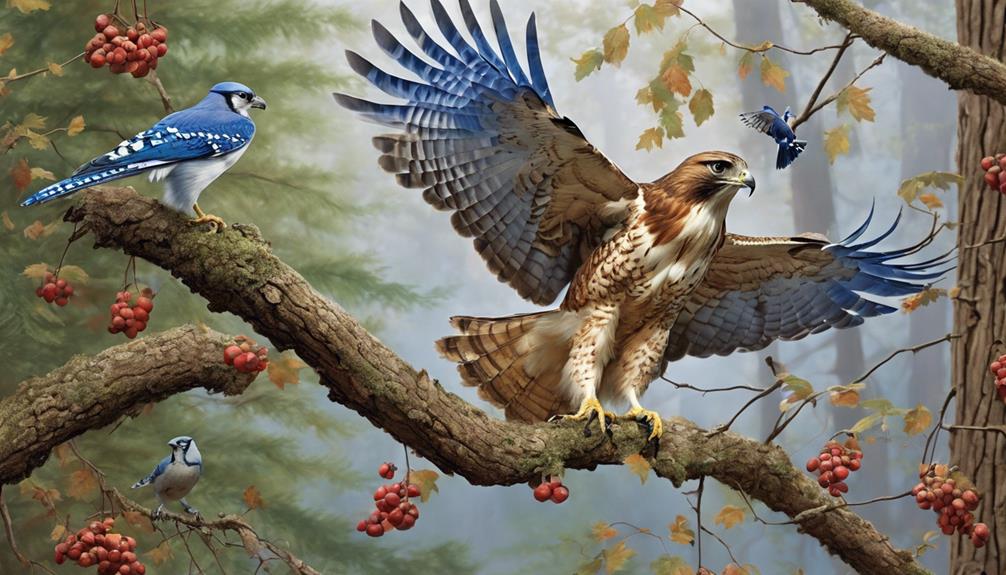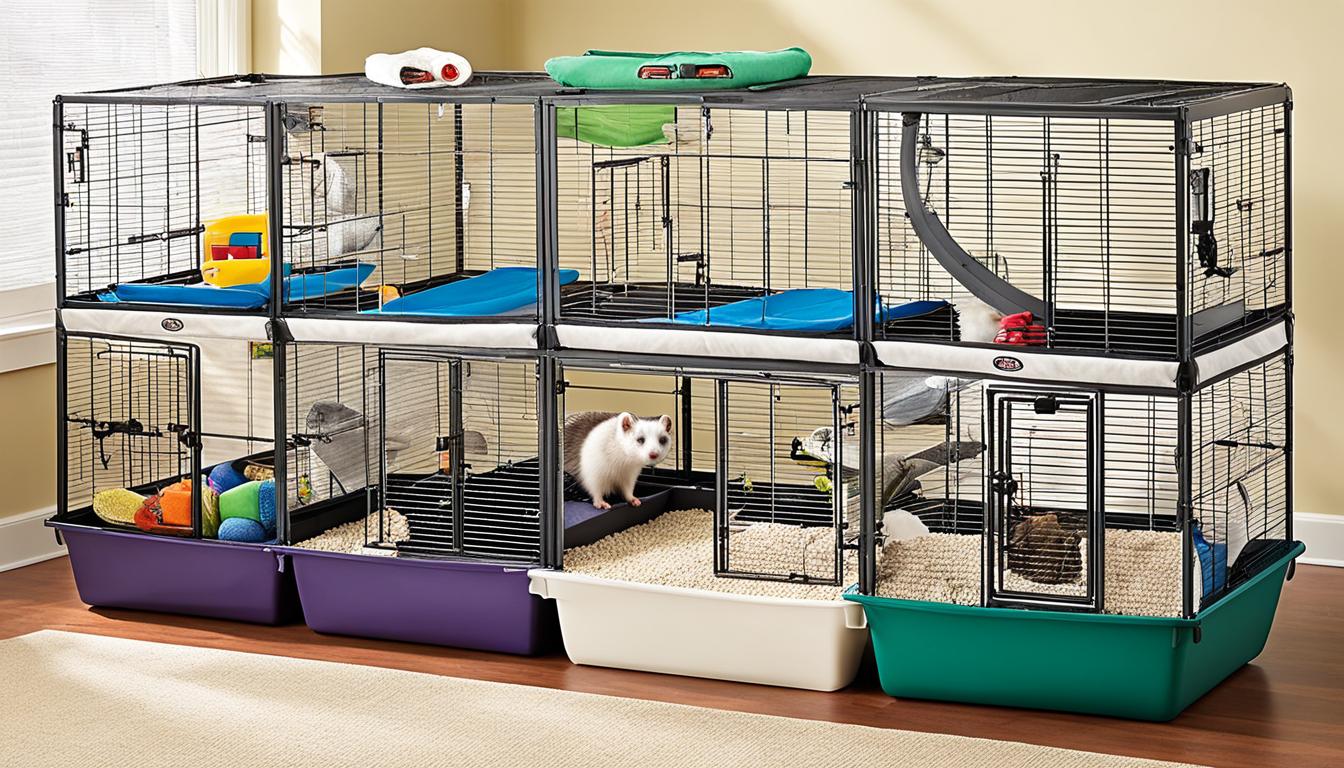Cats love heights because they instinctively seek safety and security. Elevated spots let them observe their surroundings and monitor for threats, giving them a sense of control. These high vantage points also reflect their ancestral hunting behavior, as climbing offers an advantage for spotting prey. When threatened, they instinctively retreat to higher places for refuge. If you want to understand more about your cat's fascination with heights and how it affects their well-being, just keep exploring!
Key Takeaways
- Cats instinctively seek high places for safety, reducing vulnerability to predators and threats.
- Elevated spots provide a strategic vantage point for monitoring their territory and asserting dominance.
- Climbing reflects ancestral hunting behaviors, offering an aerial advantage for spotting prey.
- High locations serve as secure retreats when cats feel threatened, fulfilling their natural instincts.
- Elevated sleeping areas enhance a cat's well-being by improving comfort and reducing stress.
The Instinctual Need for Safety

While you mightn't realize it, your cat's instinctual need for safety drives them to seek out high places. This behavior harks back to their ancestry as hunters, where elevated spots provided a strategic vantage point to spot potential predators.
By curling up in high places, your cat feels safer and more secure, allowing them to survey their surroundings. Their climbing abilities enable them to access these heights, reducing their vulnerability and giving them an escape route if needed.
This instinct isn't just about comfort; it's a critical aspect of their behavior that influences where they choose to sleep. Understanding this need can help you create a safe and cozy environment for your feline friend.
Observing the Surroundings
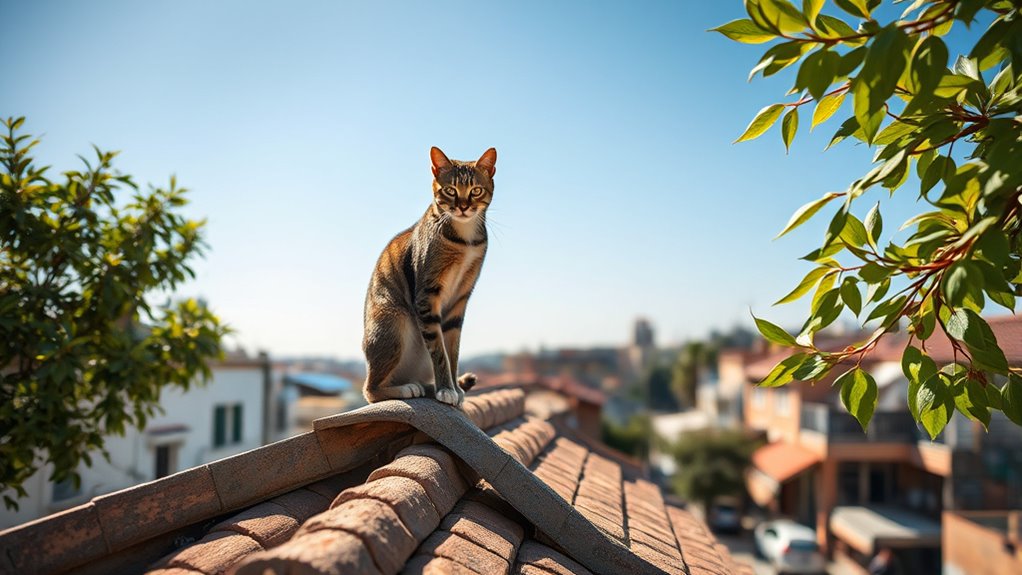
As your cat perches atop a bookshelf or gazes out a window, they're not just seeking a cozy spot; they're actively observing their surroundings. Elevated positions grant them a secure vantage point to monitor their territory and spot any potential threats or prey. This instinctual behavior stems from their ancestry as hunters, as high spots enhance their sense of security. By choosing shelves or window sills, your cat asserts dominance while keeping a watchful eye on the world below.
| Vantage Point | Benefits | Observational Abilities |
|---|---|---|
| Bookshelf | Secure from threats | Spotting intruders |
| Window Sill | Clear view of environment | Monitoring prey |
| Cat Tree | Safe retreat | Surveying territory |
| High Shelf | Enhanced security | Dominance assertion |
Ancestral Hunting Behavior

Cats have an innate instinct to climb, a behavior rooted in their ancestral hunting practices. Your feline friend's urge to seek high ground stems from early wild ancestors who relied on height to spot prey and avoid predators.
When your cat climbs to an elevated spot, it gains an aerial advantage, surveying its surroundings for potential threats or opportunities. This instinctive behavior is a vital survival tactic, helping them stay safe from dangers lurking at ground level.
Climbing not only reflects their hunting heritage but also provides a sense of security and control over their territory. By allowing your cat to explore heights, you're helping it express its natural instincts while promoting overall well-being.
Climbing for Refuge
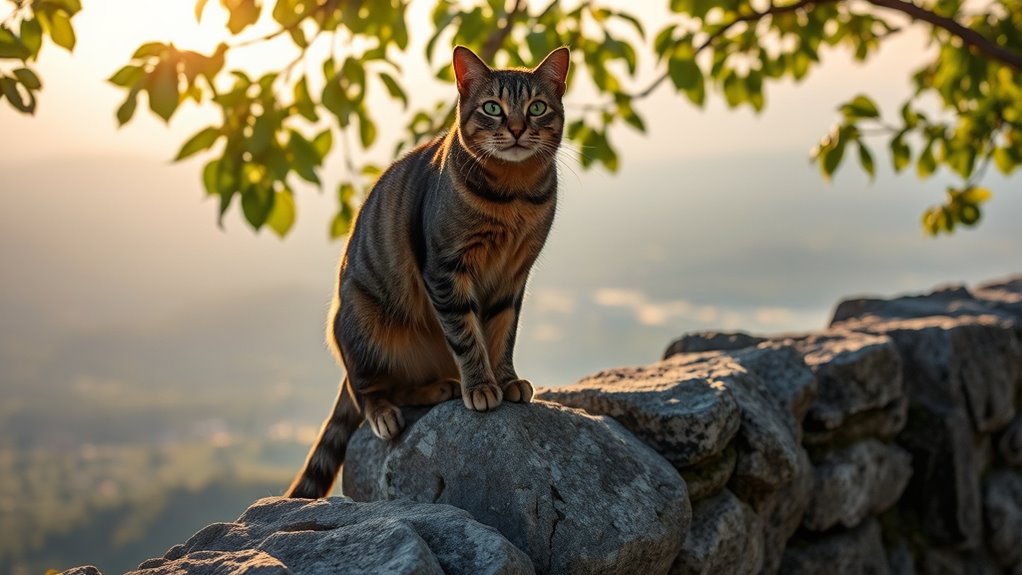
When your cat feels threatened or uncertain, it instinctively seeks refuge in high places. This behavior stems from its ancestry as a hunter, where climbing allowed it to escape dangers and survey its surroundings.
When your feline friend perches atop a shelf or climbs a tree, it gains a sense of security and control over its environment. These elevated positions not only provide a safe retreat from potential threats but also fulfill your cat's natural instincts.
Choosing high spots to sleep reinforces its need for safety and comfort. By climbing, your cat avoids ground-level dangers, making this instinctive behavior a vital survival tactic.
Security in Elevated Spaces

Elevated spaces offer your cat a sense of security that ground-level areas simply can't match. By climbing to higher spots, your cat can monitor its surroundings with ease, reducing its vulnerability to potential threats. This instinctual behavior comes from their wild ancestors, who sought refuge from predators. Elevated locales provide a single entry point, allowing your cat to detect dangers more effectively. Plus, their natural climbing abilities mean they can easily escape ground-level threats.
| Benefit | Description | Impact on Cat |
|---|---|---|
| Security | Reduced vulnerability | Higher confidence |
| Monitoring | Aerial view of surroundings | Increased awareness |
| Escape routes | Easy access to safe retreats | Enhanced safety |
| Elevated sleeping | Comfortable resting spots | Improved well-being |
| Predator avoidance | Strategic vantage points | Stress reduction |
Preference for High Vantage Points
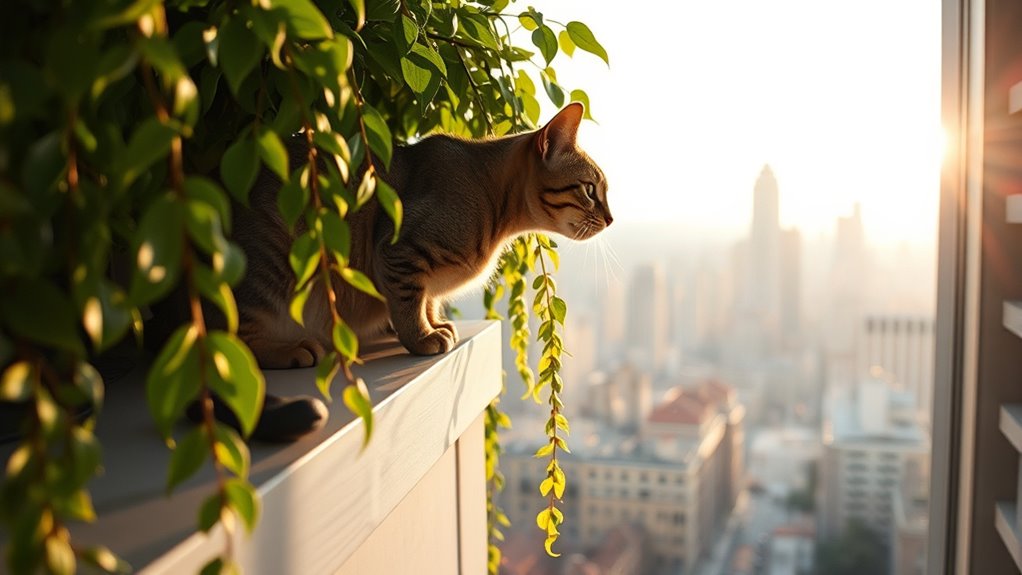
Many cats instinctively seek out high vantage points, as these spots grant them a sense of security and control over their environment. Their ancestry as skilled hunters drives this behavior, allowing them to evade predators by climbing to elevated spaces.
With their impressive climbing abilities, domestic cats can easily reach these heights, enhancing their safety while satisfying their natural instincts. From high perches, they can survey their surroundings, which reinforces their dominance in their territory.
Enhancing Comfort and Relaxation
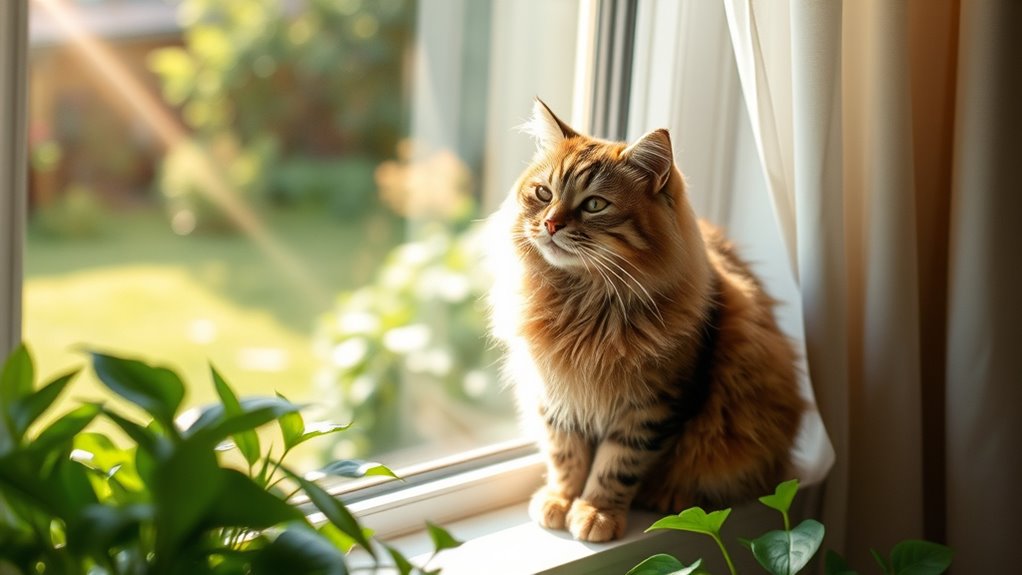
Cats naturally gravitate towards high spots not only for safety but also for enhanced comfort and relaxation.
When your cat curls up in an elevated nook, it can fully unwind, surveying its territory and feeling secure from potential threats. This instinctual behavior stems from their ancestry as hunters, where being above ground provided both comfort and a strategic edge.
High locations often offer warmth, making them cozy retreats for napping. By choosing these elevated resting places, your cat guarantees it feels at ease while sleeping, contributing to its overall well-being.
Frequently Asked Questions
Why Does My Cat Like Heights?
Your cat loves heights because it instinctively seeks out safe spots to observe its surroundings.
Climbing up gives your furry friend a sense of security, allowing it to spot potential dangers while feeling protected.
Elevated areas also provide warmth and comfort, making them ideal for napping.
Why Do Cats Like Tall Things?
Cats like tall things because they provide a perfect vantage point for observation.
When you see your cat perched high, it's not just a cozy spot; it's a strategic choice. From there, they can survey their territory, feel secure, and spot potential threats or prey.
Their natural agility makes it easy for them to climb and explore these heights, allowing them to satisfy their instincts while enjoying a warm, comfortable resting place.
What Is the 3-3-3 Rule for Cats?
Think of your cat's adjustment like a flower blooming. The 3-3-3 rule explains the typical timeline for cats settling into a new home.
In the first three days, your cat might retreat and feel stressed, like a bud still closed.
Over the next three weeks, they'll observe and start to interact.
By three months, your cat should be fully comfortable, revealing their true personality and enjoying their new environment.
Patience is key!
Why Do Cats Always Want to Be High?
You might notice your cat constantly seeking high spots, and it's all about instinct.
Cats love being elevated because it gives them a better view of their territory, helping them spot potential threats and prey. When you provide climbing areas, your cat feels safer and more in control.
Plus, those high perches let them avoid conflicts with other pets. Elevation isn't just a preference; it's an essential part of your cat's natural behavior.
Conclusion
So next time you catch your cat perched atop a bookshelf, remember it's not just about being cute. They're channeling their wild ancestors, surveying their kingdom from a lofty throne. Those high spots provide safety and a panoramic view, like a king surveying his domain. By embracing their love for heights, you're not just indulging their instincts; you're giving them a slice of the wild—where every leap is a dance, and every perch is a promise of adventure.
